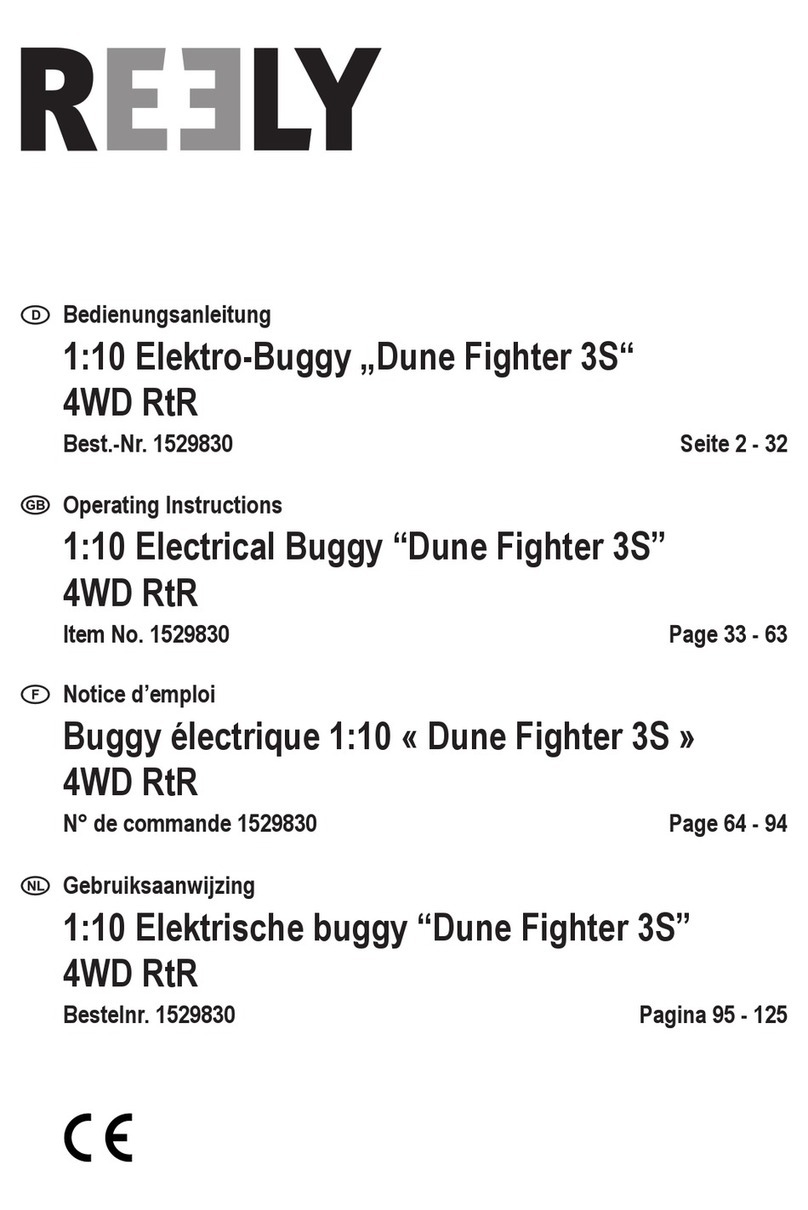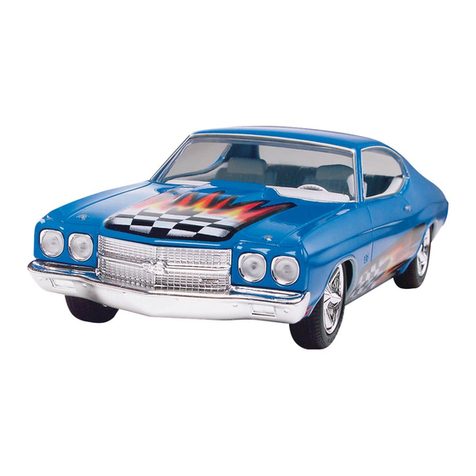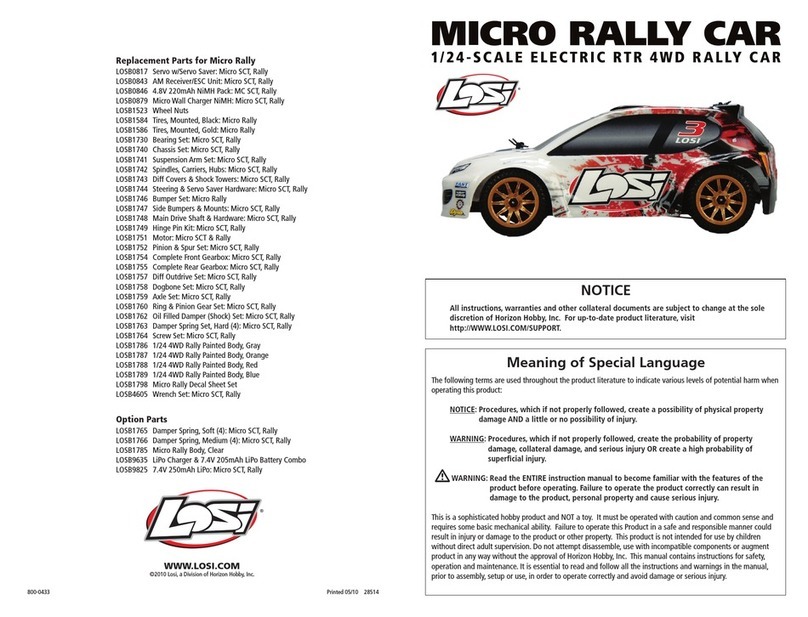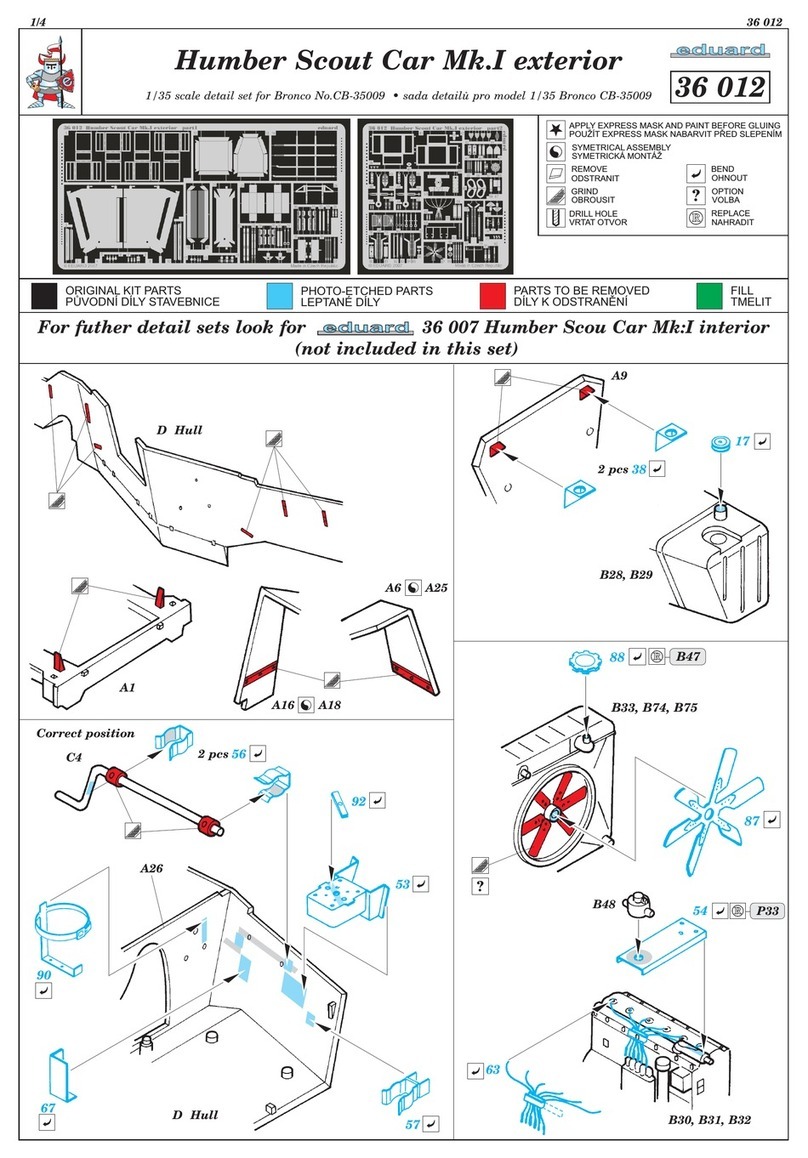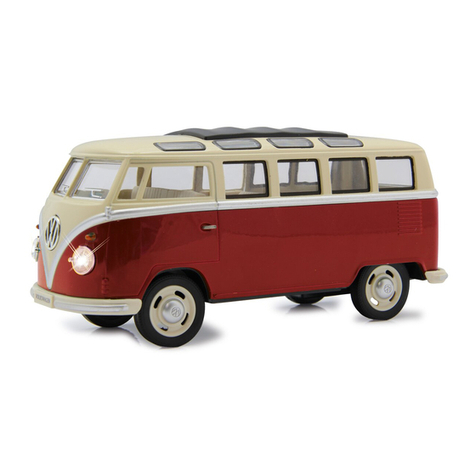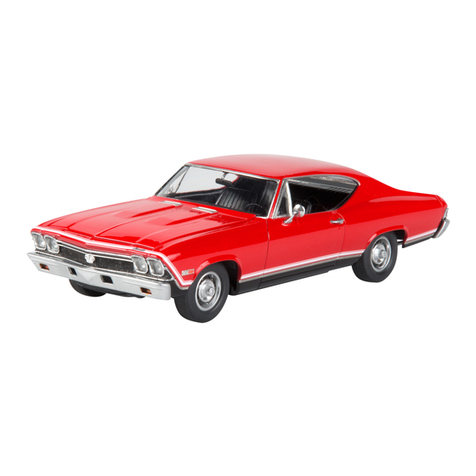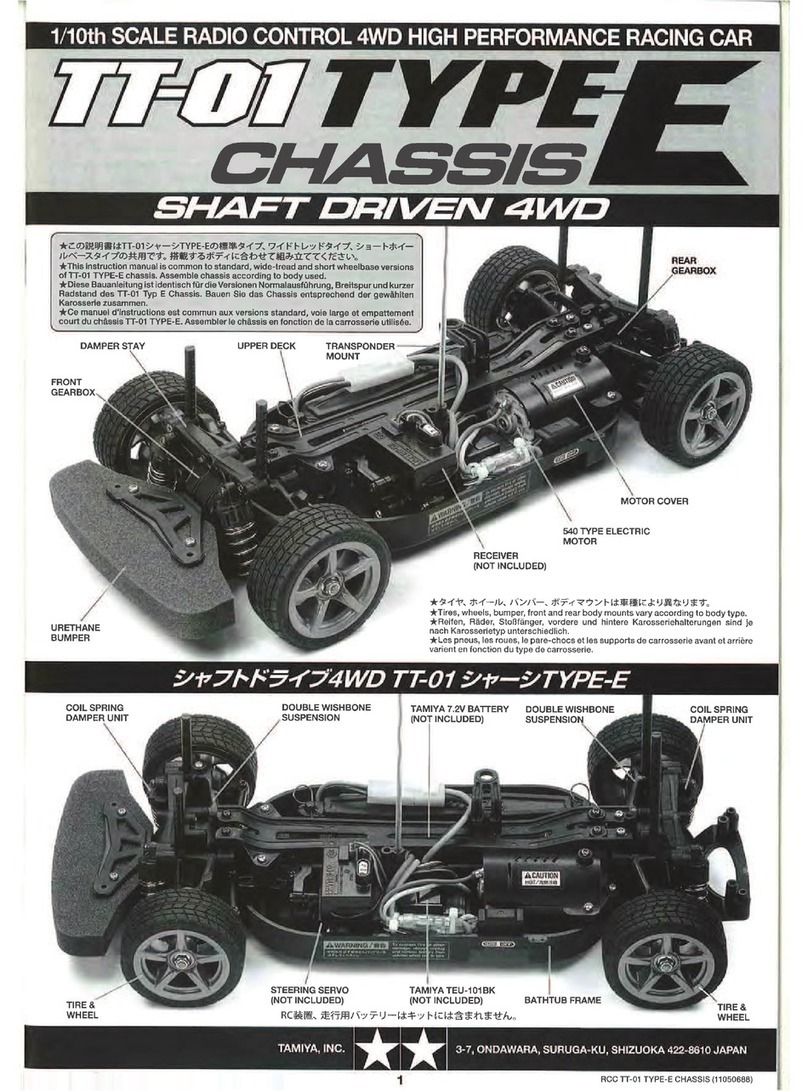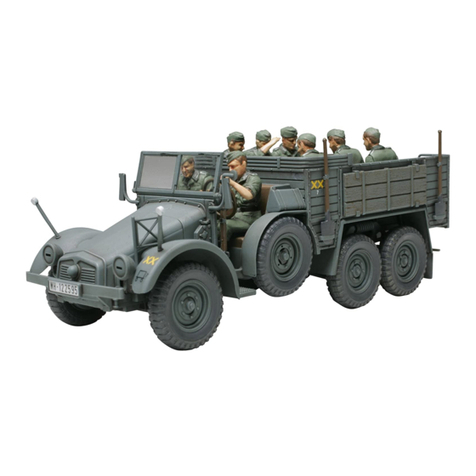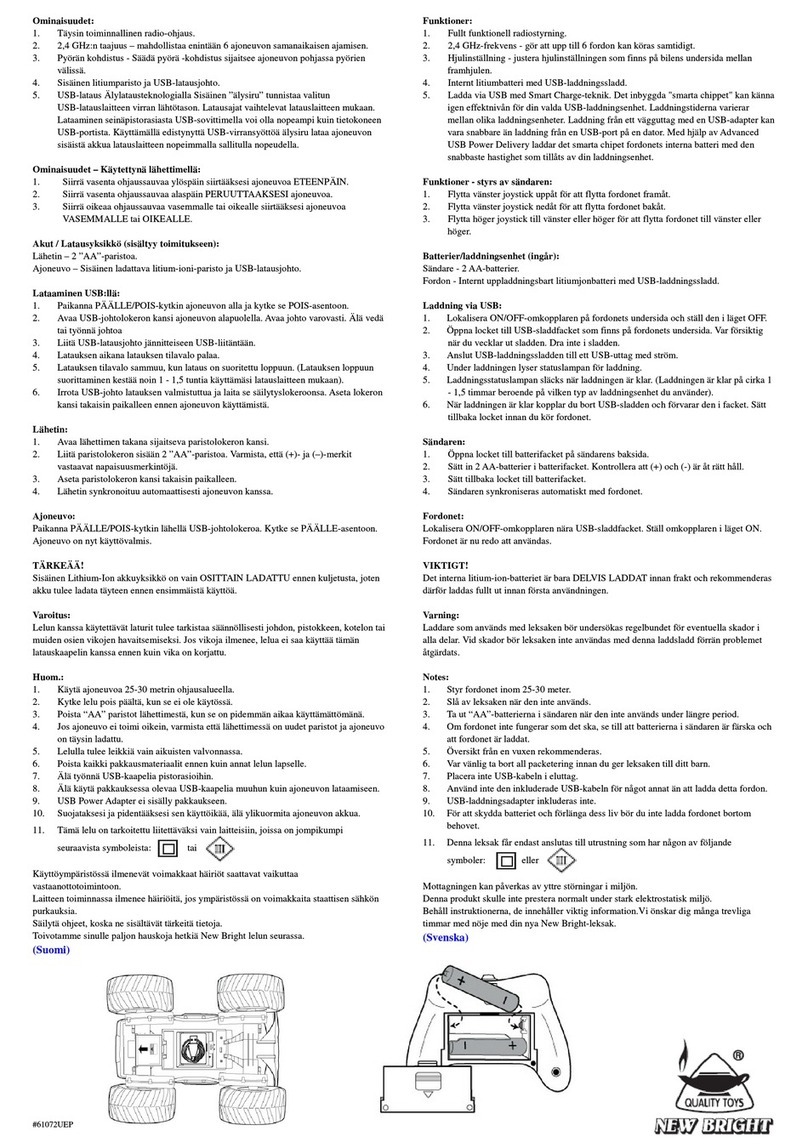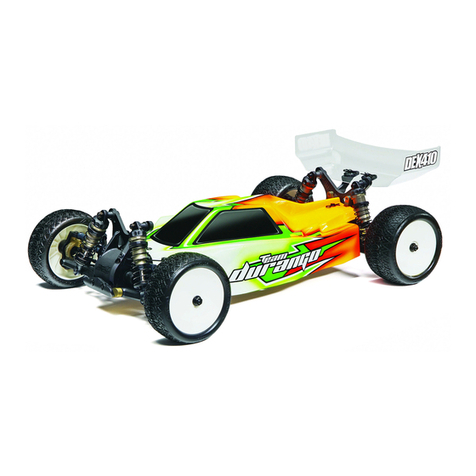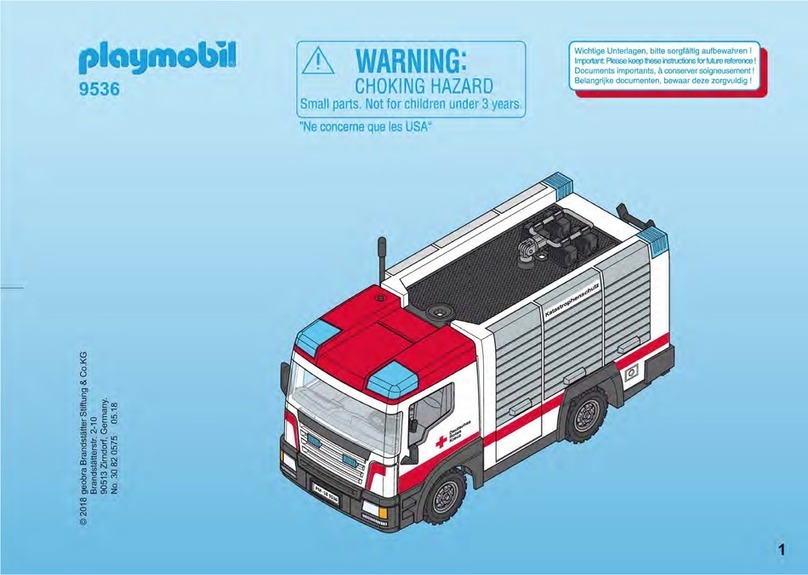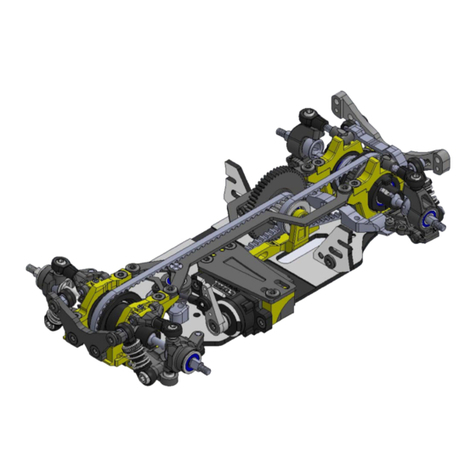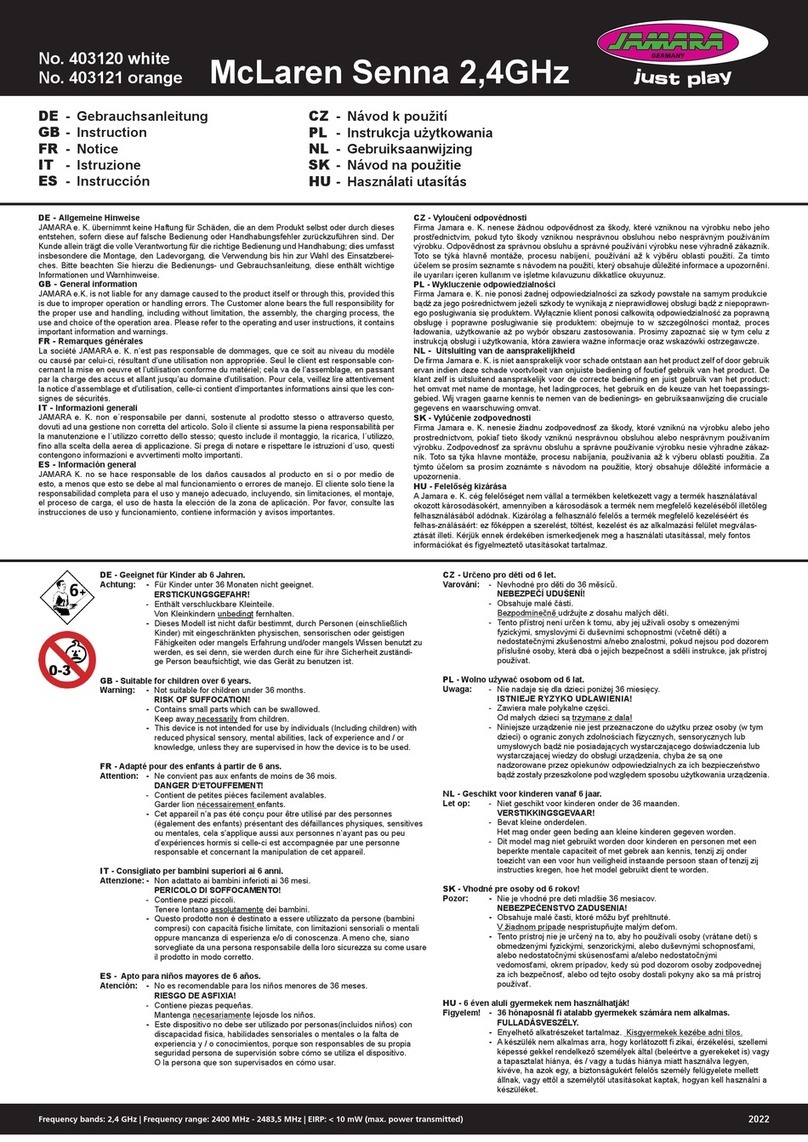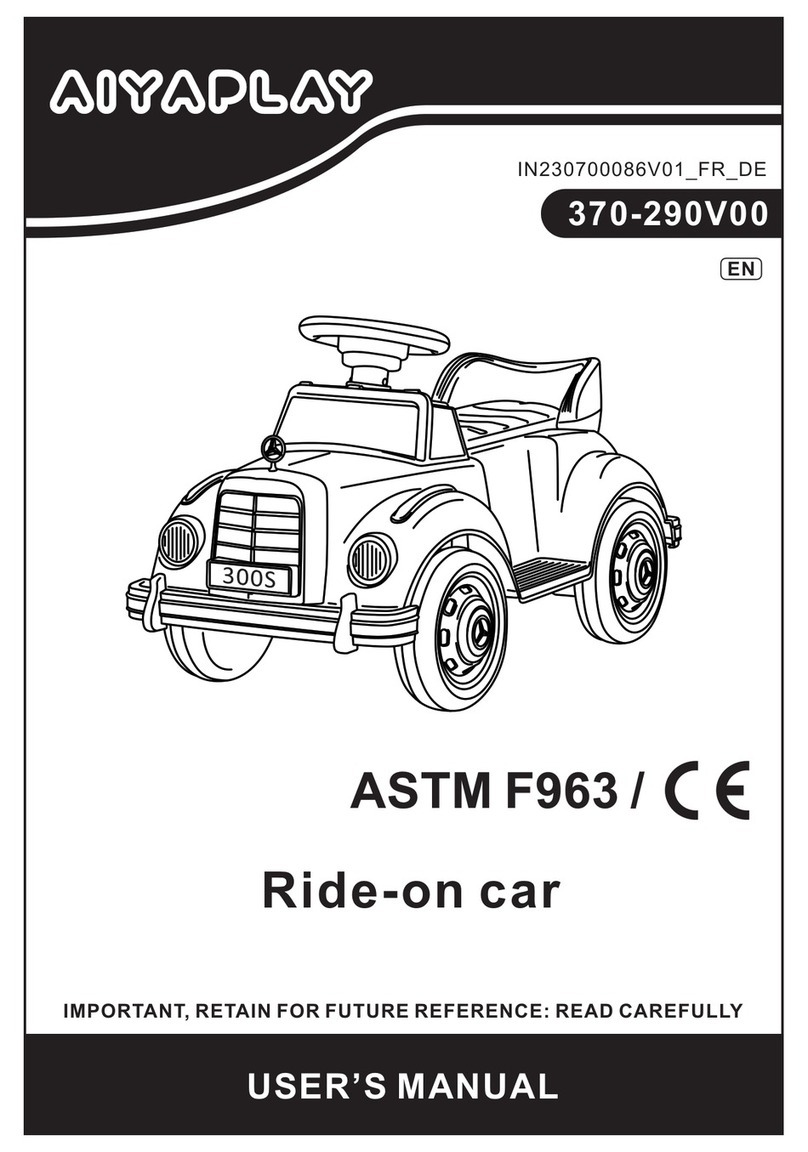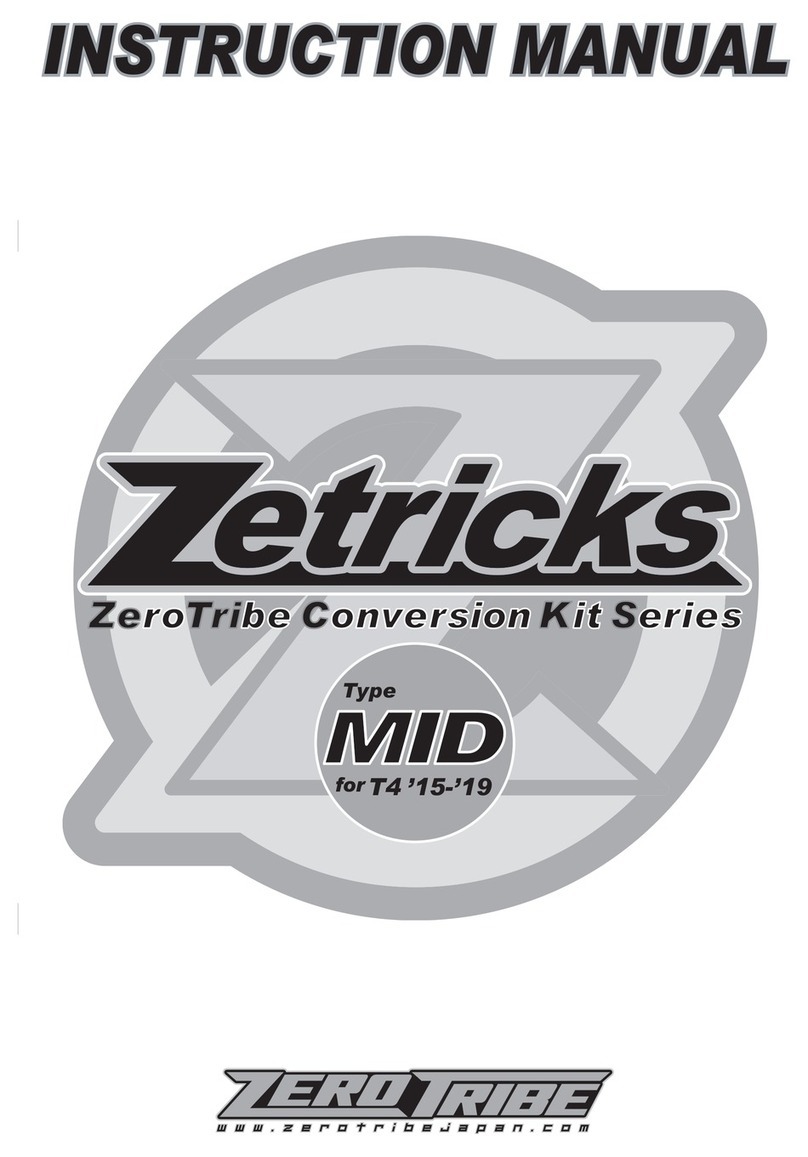Sportwerks Turmoil RTR User manual

Sportwerks™Turmoil™RTR
Assembly and Tuning Manual
Length:
19.4 in (492mm)
Width:
12.2 in (310mm)
Track:
Front: Adjustable
10.6 in–12.2 in
(270mm–310mm)
Rear 12.2 in (310mm)
Wheelbase: Adjustable
12.8 in–13.0 in (325mm–330mm)
Weight:
7.6 lb (3447 grams)
Gear Ratio:
10.86 to 1

2 • Turmoil ARR www.sportwerksRC.com
Table of Contents
Main Manual
Introduction ....................................................................................... 3
Warranty Information......................................................................... 4
Limited Warranty Period.................................................................... 4
Limited Warranty & Limits of Liability ............................................... 4
Safety Precautions ............................................................................. 4
Questions, Assistance, and Repairs................................................... 4
Inspection or Repairs......................................................................... 4
Warranty Inspection and Repairs....................................................... 5
Non-Warranty Repairs ....................................................................... 5
Recommended Tools ......................................................................... 6
Tools You Will Find Handy ................................................................. 6
Additional Items Needed to Operate .................................................. 6
Quick Start ......................................................................................... 7
Recommended Items......................................................................... 7
Recommended Engine ....................................................................... 7
The Sportwerks Carburetor.............................................................. 10
Setting the Needles.......................................................................... 10
Engine Starting and Break In ........................................................... 11
Your First Runs................................................................................ 11
Fuel and Glow Plug.......................................................................... 11
Air Filter ........................................................................................... 11
Starting Your Engine for the First Time............................................ 11
Break In ........................................................................................... 11
Starting the Engine .......................................................................... 11
Adjusting the Carburetor.................................................................. 12
Tuning Your Engine.......................................................................... 12
Fine Tuning Your Engine .................................................................. 12
Tuning the Low-Speed Needle ......................................................... 12
Setting the Idle RPM........................................................................ 13
After Run Engine Maintenance......................................................... 13
Setting the Brake Linkage ................................................................ 14
Parts Diagrams and Listings
Center Differential ............................................................................ 15
Front/Rear Differential...................................................................... 16
Front and Rear Shocks .................................................................... 17
Steering Bellcrank & Radio Tray ...................................................... 18
Front Suspension............................................................................. 19
Front Gearbox Mount....................................................................... 20
Front/Rear Center Driveshaft ........................................................... 21
Rear Suspension.............................................................................. 22
Rear Gearbox Mount........................................................................ 23
Main Chassis ................................................................................... 24
Engine/Clutch/Air Filter Assembly.................................................... 25
Fuel Tank/CVD.................................................................................. 26
Front & Rear Tire/ Wheel Assembly................................................. 27
Parts Listings..............................................................................28-43
Additional Information
Turmoil Specifications and Helpful Information............................... 44
Brake Knob Color Code.................................................................... 44
Chassis Specifications ..................................................................... 44
Ball Bearings.................................................................................... 44
Fluids Used in the Turmoil............................................................... 44
ROAR and IFMAR 1/8-Scale Buggy Rules ....................................... 44
Set Up Tips ...................................................................................... 45
Differential Fluids ............................................................................. 45
Choosing Tires................................................................................. 45
Caster............................................................................................... 45
Shock Locations .............................................................................. 45
Lower Shock Positions .................................................................... 45
Upper Shock Positions .................................................................... 45
Turmoil Setup Sheet ...................................................................46-47

Turmoil Pro • 3www.sportwerksRC.com
Introduction
Thanks for your purchase of the Turmoil™RTR. Hang on—you’re about
to discover just how much fun trying to tame an overpowered 1/8-scale
nitro buggy can be. In just minutes you’ll be ripping up the dirt, at speeds
over 40 mph.
The Turmoil chassis is based on the race winning design of the Sportwerks™
Turmoil Pro racing buggy. Professionally built and hand assembled by the
Sportwerks team. The shocks and differentials are pre-filled with the correct
lubes for optimum handling and performance. The Turmoil RTR comes
assembled with radio, engine, and exhaust installed. All you need to make
it race-ready is to install a 6-cell pack in the handheld starter and 12 AA
batteries in the transmitter and receiver.
The front section of this manual features a 6-step quick start guide that
will take you from box to race-ready in about 15 minutes. Also included
are exploded view isometric drawings, with part numbers and parts
listings which are helpful when disassembling your Turmoil for repair or
maintenance. For those who want to feel the thrill of competition at a local
track, the Sportwerks team has a baseline setup sheet available online at
www.sportwerksrc.com. A blank version is also provided at the back of
the manual to help you record your own race settings. The last page also
includes helpful information and specifications for your Turmoil.
Good luck, have fun and enjoy the fun of R/C with your new Turmoil ST.

4 • Turmoil ARR www.sportwerksRC.com
Safety, Precautions, and Warnings
This model is controlled by a radio
signal that is subject to interference
from many sources outside your
control. This interference can cause
momentary loss of control so it
is advisable to always keep a safe
distance in all directions around your
model, as this margin will help to avoid
collisions or injury.
• Always operate your model in an
open area away form cars, traffic,
or people.
• Avoid running your model in the
street where injury or damage
can occur.
• Never run the model out into
the street or populated areas for
any reason.
• Never run your model with low
transmitter batteries.
• Carefully follow the directions and
warnings for this and any optional
support equipment (chargers,
rechargeable battery packs, etc.) that
you use.
• Keep all chemicals, small parts and
anything electrical out of the reach
of children.
• Moisture causes damage to
electronics. Avoid water exposure
to all equipment not specifically
designed and protected for this
purpose.
Warranty Information
Limited Warranty Period
Horizon Hobby, Inc. guarantees this product to be free from defects in both
material and workmanship at the date of purchase.
Limited Warranty & Limits of Liability
Pursuant to this Limited Warranty, Horizon Hobby, Inc. will, at its option, (i)
repair or (ii) replace, any product determined by Horizon Hobby, Inc. to be
defective. In the event of a defect, these are your exclusive remedies.
This warranty does not cover cosmetic damage or damage due to acts of
God, accident, misuse, abuse, negligence, commercial use, or modification
of or to any part of the product. This warranty does not cover damage due to
improper installation, operation, maintenance, or attempted repair by anyone
other than an authorized Horizon Hobby, Inc. service center. This warranty
is limited to the original purchaser and is not transferable. In no case shall
Horizon Hobby’s liability exceed the original cost of the purchased product
and will not cover consequential, incidental or collateral damage. Horizon
Hobby, Inc. reserves the right to inspect any and all equipment involved in a
warranty claim. Repair or replacement decisions are at the sole discretion of
Horizon Hobby, Inc. Further, Horizon Hobby reserves the right to change or
modify this warranty without notice.
REPAIR OR REPLACEMENT AS PROVIDED UNDER THIS WARRANTY IS THE
EXCLUSIVE REMEDY OF THE CONSUMER. HORIZON HOBBY, INC. SHALL
NOT BE LIABLE FOR ANY INCIDENTAL OR CONSEQUENTIAL DAMAGES.
As Horizon Hobby, Inc. has no control over use, setup, final assembly,
modification or misuse, no liability shall be assumed nor accepted for any
resulting damage or injury. By the act of use, setup or assembly, the user
accepts all resulting liability.
If you as the purchaser or user are not prepared to accept the liability
associated with the use of this product, you are advised to return this
product immediately in new and unused condition to the place of purchase.
Safety Precautions
This is a sophisticated hobby product and not a toy. It must be operated
with caution and common sense and requires some basic mechanical ability.
Failure to operate this product in a safe and responsible manner could result
in injury or damage to the product or other property. This product is not
intended for use by children without direct adult supervision.
The product manual contains instructions for safety, operation and
maintenance. It is essential to read and follow all the instructions and
warnings in the manual, prior to assembly, setup or use, in order to operate
correctly and avoid damage or injury.
Questions,Assistance, and Repairs
Your local hobby store and/or place of purchase cannot provide warranty
support or repair. Once assembly, setup or use of the product has been
started, you must contact Horizon Hobby, Inc. directly. This will enable
Horizon to better answer your questions and service you in the event that
you may need any assistance.
For questions or assistance, please direct your email to
productsupport@horizonhobby.com, or call 877.504.0233 toll free to
speak to a service technician.
Inspection or Repairs
If your product needs to be inspected or repaired, please call for a Return
Merchandise Authorization (RMA). Pack the product securely using a
shipping carton. Please note that original boxes may be included, but are not
designed to withstand the rigors of shipping without additional protection.
Ship via a carrier that provides tracking and insurance for lost or damaged
parcels, as Horizon Hobby, Inc. is not responsible for merchandise until it
arrives and is accepted at our facility. Include your complete name, address,
phone number where you can be reached during business days, RMA
number, and a brief summary of the problem. Be sure your name, address,
and RMA number are clearly written on the shipping carton.

Turmoil Pro • 5www.sportwerksRC.com
Warranty Inspection and Repairs
To receive warranty service, you must include your original sales receipt
verifying the proof-of-purchase date. Providing warranty conditions have
been met, your product will be repaired or replaced free of charge. Repair or
replacement decisions are at the sole discretion of Horizon Hobby.
Non-Warranty Repairs
Should your repair not be covered by warranty and the expense exceeds
50% of the retail purchase cost, you will be provided with an estimate
advising you of your options. You will be billed for any return freight for
non-warranty repairs. Please advise us of your preferred method of payment.
Horizon Hobby accepts money orders and cashiers checks, as well as Visa,
MasterCard, American Express, and Discover cards. If you choose to pay by
credit card, please include your credit card number and expiration date. Any
repair left unpaid or unclaimed after 90 days will be considered abandoned
and will be disposed of accordingly.
Electronics and engines requiring inspection or repair should be shipped to
the following address (freight prepaid):
Horizon Service Center
4105 Fieldstone Road
Champaign, Illinois 61822
All other products requiring inspection or repair should be shipped to the
following address (freight prepaid):
Horizon Product Support
4105 Fieldstone Road
Champaign, Illinois 61822

6 • Turmoil ARR www.sportwerksRC.com
ToolsYou Will Find Handy
In addition to the tools included in this kit, you will find the following items
useful when performing maintenance or repair to your Turmoil.
• 1.5mm hex wrench
• 2mm hex wrench
• 2.5mm hex wrench
• 3mm hex wrench
• 5.5 mm nut driver
• #2 flat screwdriver
• #1 Phillips screwdriver
• Needle-nose pliers
• Scissors
• Servo tape
• Clutch spring tool
• Header spring tool
• Piston lock or crank lock tool
• 10mm deep socket wrench
Additional Items Needed to Operate
• 6-cell 7.2 volt car pack (DYN1000 recommended)
• 12 “AA” Alkaline batteries
• 1 “C” Alkaline battery (for glow igniter)
• Air filter oil
• Car fuel
• Fuel bottle
Recommended Tools
SWK9920
Metric Allen Driver Set
SWK9912
3 in 1 Tuning Screwdriver
SWK9910
EZ-On Clutch Spring Tool
SWK9911
Header Spring Tool
SWK9914
1/8 Scale Turnbuckle Wrench
DYN2828
#1 Phillips Screwdriver
DYN2511
Curved Lexan Scissors
Recommended Items
DYN1000
Dyna-Sport 7.2 1500mAh Battery
DYN2502
Air Filter Oil
DYN2320
Blue Thunder Sport Fuel 20%
DYN2003
500cc Fuel Bottle

Turmoil Pro • 7www.sportwerksRC.com
Quick Start
1. Install 8 “AA” batteries in the transmitter noting the proper
direction of each cell.
2. Open the radio box and install 4 “AA” batteries in the battery
holder noting the proper direction of each cell.

8 • Turmoil ARR www.sportwerksRC.com
3. Insert the antenna tube in the top of the radio box. Feed the
receiver antenna through the tube until several inches extend out
the top. Install the antenna tip.
4. Install a charged 6-cell 7.2-volt battery in the starter and attach
the plug.

Turmoil Pro • 9www.sportwerksRC.com
5. Turn on the transmitter and then the receiver. Check to make
sure the servos are operating correctly and that the carburetor
closes when the throttle trigger is released. 6. Apply air filter oil (not included) and spread the oil uniformly onto
the air filter allowing it to saturate the foam element.
Congratulations—your Turmoil is ready to rip!

10 • Turmoil ARR www.sportwerksRC.com
The Sportwerks Carburetor
The Sportwerks™.26 v2 engine features a slide-valve carburetor and includes
two inserts of varying diameters. The carburetor inserts are used to change
the power curve and response of the engine. The two inserts included have
the following effect:
7.5mm – Develops good mid-range power; easier to control than the 9mm
insert; best for medium traction conditions.
9mm – Offers explosive, sometimes difficult to control, acceleration; uses the
most fuel; used only for high traction, or expert drivers.
Setting the Needles
While the needles are pre-set at the factory, it’s a good idea to verify that
the needles are properly set slightly rich for break in. The following are the
recommended settings for your new engine.
High-Speed Needle: 3 1/2turns out
Low-Speed Needle: 2 turns out (counterclockwise) from closed.
Note: When checking the adjustment of the low-speed needle, it is
crucial that the throttle slide is closed completely and that you do
not over-tighten the needles. When you feel resistance, immediately
stop turning. This is the closed position.
High-Speed
Needle Valve
Leaner
Low-Speed
Needle Valve
Fuel Inlet
(Adjustable)
Idle Stop
Adjustment
Faster Idle
(clockwise)
Slower Idle
(counterclockwise)
Leaner

Turmoil Pro • 11www.sportwerksRC.com
Engine Starting and Break In
Your First Runs
If this is your first nitro vehicle, we highly recommend that you have an
experienced nitro tuner help during the first startups and runs. He will be
able help you properly adjust your engine for reliable performance.
Before attempting to start your new buggy, be sure to read this section
and fully understand each step before starting your engine, Pay particular
attention to the needle settings recommended for starting and to the break in
procedures suggested below. Always use the proper fuel and glow plugs.
Fuel and Glow Plug
Note: Using the proper fuel and glow plug is vital in achieving
reliable performance and is a must for long engine life. You
must use fuel and glow plugs that are specifically designed for
model car use.
Never use any type of model airplane glow fuel. We recommend a high-
quality car fuel containing 20% nitro methane (Blue Thunder™20% Sport
Fuel is recommended). A glow plug is included that is ideal for breaking
in your new engine. During the break-in process, it’s not uncommon to
go through one or two glow plugs, as microscopic particles of metal
(from the cylinder/piston wearing in) bond themselves to the plug element
causing glow plug failure. We recommend the Dynamite®MC-59 Glow Plug
(DYN2508) as the best replacement glow plug for this engine.
Air Filter
A clean properly oiled air filter is a must to keep dirt out of the engine. Use
the included air filter and saturate the foam element with oil.
Starting Your Engine for the First Time
Break In
The first startups and the first 3 to 4 tanks of fuel while your engine is
running is the most critical of its life and, in many ways, dictates how well it
will perform and how long it will last.
During the first runs, when the engine starts, the exhaust should emit blue/
white smoke indicating that the engine is rich (a good thing during break in).
During the first tank of fuel, you may wish to set a higher than normal idle
speed in order to keep your engine from stalling. Drive your buggy around
while blipping the throttle, and avoid operating the engine at full throttle for
more than 2–3 seconds at a time. Run the entire first two tanks of fuel in this
manner. After the first two tanks, begin leaning out the high-speed needle
valve 1/8 turn at a time. It usually take about 5 or 6 tanks of fuel before
you’d want to start leaning your engine for maximum power. Patience will be
rewarded after break in with an engine that performs reliably to its maximum
power potential. Remember glow plug failure is a common occurrence when
breaking in a new engine. To test your plug, let the engine idle at a properly
adjusted low-speed setting with the glow igniter attached. Then, remove
the igniter. If you hear no appreciable change in engine rpm, the plug is still
good. If the engine loads up and the rpm’s decrease, it’s time to replace the
glow plug.
Starting the Engine
1. Fill the tank with fuel.
2. Turn on the transmitter and receiver and confirm that the radio
system is working properly.
3. Attach the glow driver to the glow plug.

12 • Turmoil ARR www.sportwerksRC.com
4. Fully insert the electric start shaft into the back of the engine.
Press the start button for ten seconds then stop. The engine
should turn over but likely won’t yet start. Continue these
ten-second starting attempts several times until the engine starts.
Note: Should the engine not turnover when the starter is applied,
the engine maybe flooded (hydro-locked). Excess fuel in the
combustion chamber can prevent the piston from traveling through
its full range of compression, effectively “locking up” the engine.
Should this occur, remove the glow plug igniter from the plug and,
using a glow plug wrench (DYN2510), remove the glow plug and
turn the buggy upside down. Give the starter a few short blips to
clear the fuel from the combustion chamber then re-install the glow
plug and try again.
You may find it necessary to blip the throttle on the transmitter (applying the
throttle on/off) while trying to start the engine, as new engines are harder
to start due to the tight piston/cylinder fit. Never start an engine above 1/4
throttle or damage to your engine could occur.
Adjusting the Carburetor
Tuning Your Engine
When tuning the needle valves for maximum performance, adjust them in
small increments, 1/16 turn at a time. An engine should not be run too lean;
doing so will severely shorten the life of the engine. When an engine is set
too lean, it will run very strong at first but soon begin to sag and hesitate
or stall when accelerating. The best way to tune an engine is by using an
infrared temperature gauge, but you can also use water to check the head
temperature. (Refer to “Fine Tuning Your Engine”)
Fine Tuning Your Engine
As you gain experience, you will be able to tune your engine based on its
sound and feel during acceleration and at full throttle. Until you’ve developed
this skill, we recommend the following method of engine tuning. Start your
engine and drive your buggy aggressively for about two minutes. Place a
drop of water on the cylinder head. If the water sizzles away (evaporates
immediately), the needle setting is too lean. A correct needle setting will
result in the water evaporating slowly, in about 5–10 seconds. If the water
does not evaporate, the needle setting is too rich. Lean the high-speed
needle 1/8 of a turn and run the engine again, adjusting the needle setting to
the desired evaporation rate of 5–10 seconds. Check the temperature each
time you change the needle mixture. Do not let the engine overheat, this will
damage the engine.
Tuning the Low-Speed Needle
The low-speed needle (also referred to as the idle mixture or idle needle)
should be set after you’re satisfied with the high-speed needle setting. After
achieving the engine’s proper operating temperature, reduce the engine
throttle to idle for about 15 seconds. Now pinch the fuel line with your
fingers close to the carburetor fuel inlet nipple while carefully listening to
the engine rpm. If the engine dies immediately without an increase in rpm,
the low speed needle is set too lean. If the rpm’s increase dramatically and
then the engine dies, the setting is too rich. The ideal setting results in the
rpm’s increasing a slight amount (about 200rpm's after pinching the fuel line
before dying.

Turmoil Pro • 13www.sportwerksRC.com
Setting the Idle RPM
The last setting to be made is the idle rpm. Turning the idle stop screw
clockwise increases the idle speed. Turning the screw counterclockwise will
make the engine idle at a lower rpm. Ideally, the engine should idle just fast
enough to give a reliable idle but not engage the clutch and, of course, never
flame out.
After Run Engine Maintenance
After you’re finished racing for the day, it’s important to empty the fuel tanks
and run the remaining fuel from the engine. Continue to try and start the
engine for several seconds after it will no longer fire to ensure that all fuel
is out of the engine. Put several drops of after run oil in the carburetor and
turn the engine over with the starter for several seconds to coat the internal
engine parts with after run oil.
Clean the air filter regularly using warm soapy water, then allowing it to air
dry before applying air filter oil. Keeping your air filter clean and oiled is vital
to the life of your engine.

14 • Turmoil ARR www.sportwerksRC.com
Setting the Brake Linkage
1. Turn on the radio system and adjust the throttle trim to the
desired neutral position.
2. Install the arm with attached linkage on the servo adapter such
that the brake linkage will be parallel to the arm with the brake
ball links attached.
3. Be sure the ball links are snapped onto the front and rear brake
and on the carburetor.
Note: It may be necessary to adjust the position of the throttle
return spring to allow the ball link to snap on the ball.
4. Adjust the position of the return spring collar until the correct
tension is achieved. With the throttle at neutral, the spring should
just close the carburetor barrel with light tension.
5. Loosen the setscrew in the blue knurled knob and slide the knob
such that it just contacts the molded pivot on the arm, then
retighten the setscrew.
6. Adjust the full throttle position with the programming in your
transmitter such that the carburetor is full open just as the trigger
reaches the full throttle position. By rotating the blue throttle
knob, you can now precisely adjust the throttle dead band (the
amount the throttle moves before the carburetor barrel actually
opens) without disturbing the spring preload settings.
7. With the throttle at neutral, pull the front (silver knob) brake
linkage through the molded pivot such that the front brakes are
slightly applied. Loosen the setscrew on the silver adjusting knob
and slide it into position such that it just contacts the molded
pivot and retighten the setscrew.
8. With the throttle at neutral, pull the rear (red knob) brake linkage
through the molded pivot such that the rear brakes are slightly
applied. Loosen the setscrew on the red adjusting knob and slide
it into position such that it just contacts the molded pivot and
retighten the setscrew.
9. Cut the excess lengths of linkage off to clear the body. By rotating
the silver adjusting knob, the front brakes can be accurately
adjusted while rotating the red knob will affect the rear brake
adjustment.

Turmoil Pro • 15www.sportwerksRC.com
91
89
89
90
89
89
18
41
89
18
79
90
89
89
89
41
91
91
50
20
86
82
57
88
84
83
84
84
50 85
82
57
81
79
4
3
91
91
20
96
93
37
93
93
93
37
21
156 96
Center
Differential

Rear Differential
Front Differential
16 • Turmoil ARR www.sportwerksRC.com
57
78 4
80
57 50
84
83
84 83
83
84
86
84
8483
5082
85
88
87
57
78
Front/Rear
Differential
57
78 87
50 84
83
88
82
86
84
85
83
84 57
4
80
82
50
83
84
83
84
78

Rear ShockFront Shock
Turmoil Pro • 17www.sportwerksRC.com
73, 75
76
71, 72, 73
72, 73
71, 72, 73
29, 72, 73
72, 73
65, 73
68, 73
64, 73
73, 75
63, 73
33, 73
70, 73
72, 73
26, 73
34, 73
62
170
67, 73
72, 73
45, 73, 75
44
64, 74
72, 74
74, 75
34, 74
26, 74
63, 74
67, 74
70, 74
72, 74
29, 72, 73
71, 72, 74
72, 74
71, 72, 74
33, 74
72, 74
44
45, 74, 75
74, 75
69, 74
66, 74
77
170
62
Front and Rear
Shocks

18 • Turmoil ARR www.sportwerksRC.com
3
22
3
22
193
95, 192
95
95
95, 192
45
52
45
44, 95
95
95
44, 95
45
52 45
95
95
95
95
95 95
26
26
51
34
45
26
13
45
95
95
Steering
Bellcrank &
Radio Tray
182
182
31, 97
27, 97
100
31, 97
30, 97
30, 97
98
98
30, 97
97
97
97
97
37, 96
96 96
96
96
96
37, 96
96
96
37, 96
96
37, 96
96
96
96
96
96
96
2, 96
96
26
23
23
22
26
96
96
96
96
96
4,96 96
96
99
99
157
24
158
23
23
23 26
34
12
96
2, 96 96
96
99
22
26

Turmoil Pro • 19www.sportwerksRC.com
110
191
106
191
109 48
184
190
28
6
24
130
28
57
13
118
26
106
106
107
107
23
23 107
107
54
50, 128
57
127
40
106
47
111
101
101
Front
Suspension

20 • Turmoil ARR www.sportwerksRC.com
133
18
110
115
37
5
99
23 23 161
112
108
37 17
37
133
38 44
44, 133
45, 133
45, 133
24
112
125
34
164
112
182
162
25 23
19
61
17
18
163
Front Gearbox
Mount
Table of contents
Other Sportwerks Motorized Toy Car manuals

Sportwerks
Sportwerks Tailwhip Installation and operating instructions

Sportwerks
Sportwerks Mayhem ST Installation and operating instructions

Sportwerks
Sportwerks SWK1455 User manual
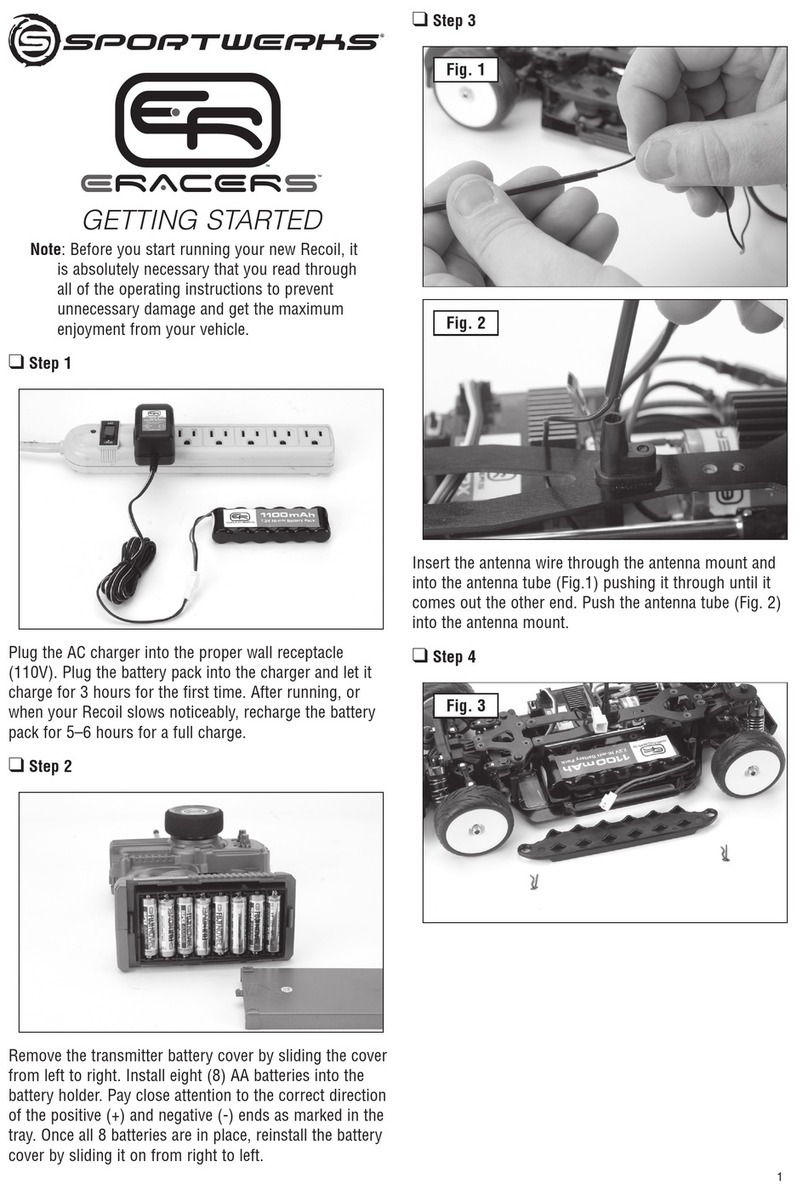
Sportwerks
Sportwerks E-RACERS RECOIL User manual
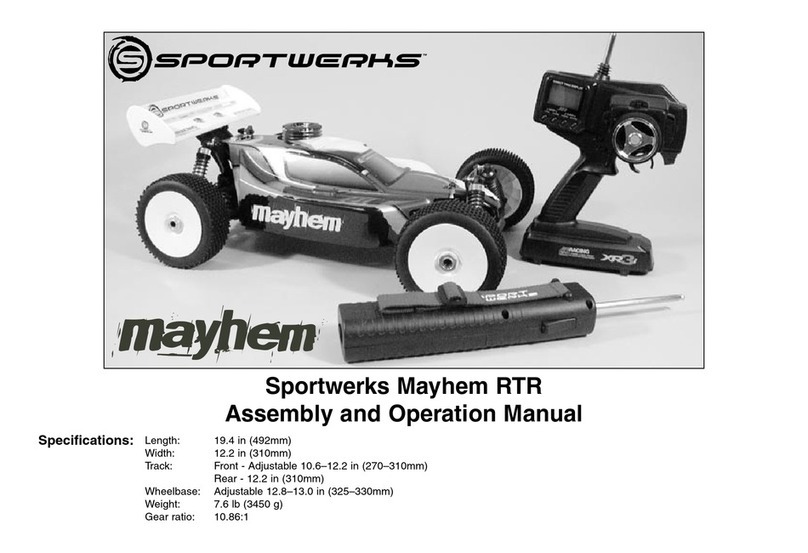
Sportwerks
Sportwerks Mayhem Installation and operating instructions
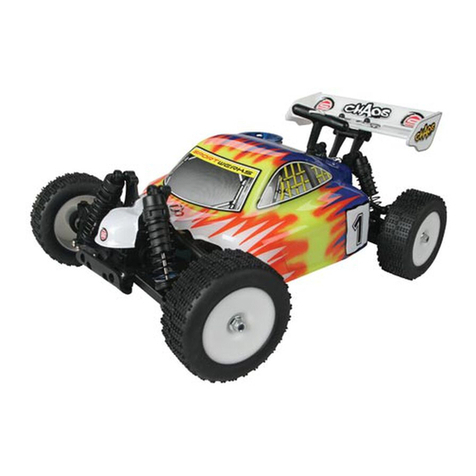
Sportwerks
Sportwerks Chaos User manual
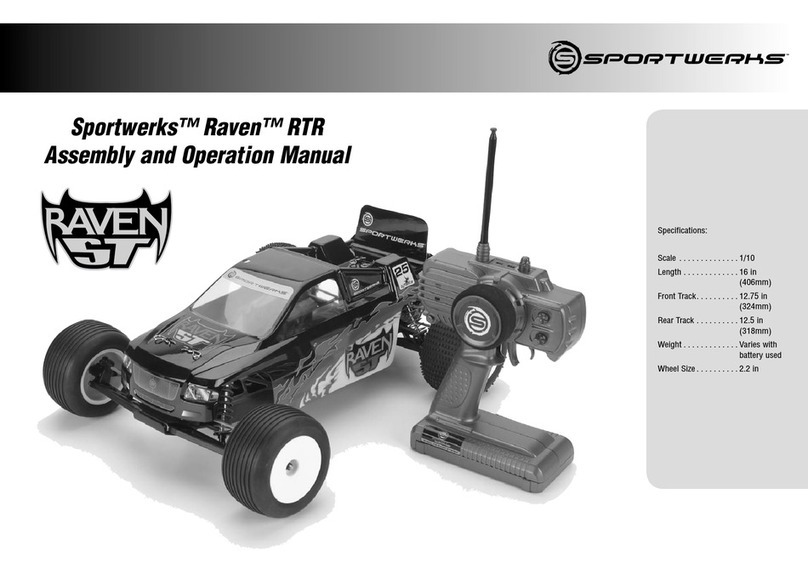
Sportwerks
Sportwerks Raven ST Installation and operating instructions
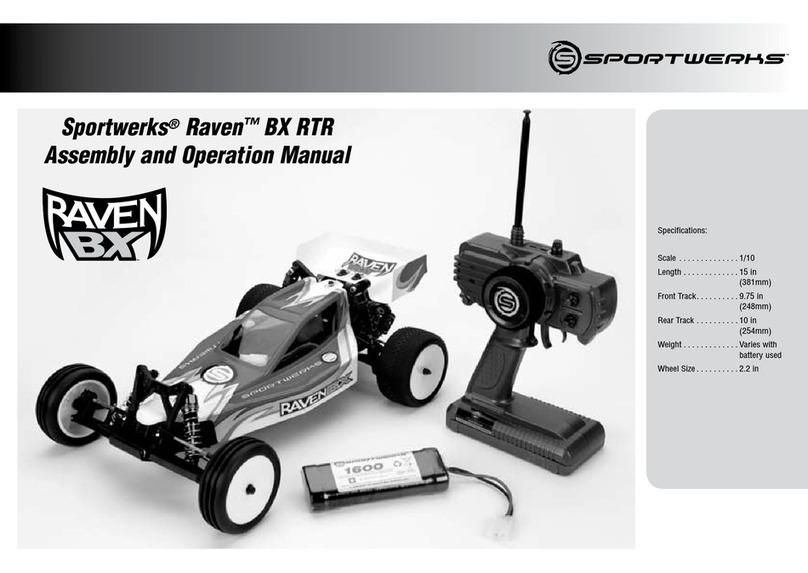
Sportwerks
Sportwerks Raven BX RTR Installation and operating instructions
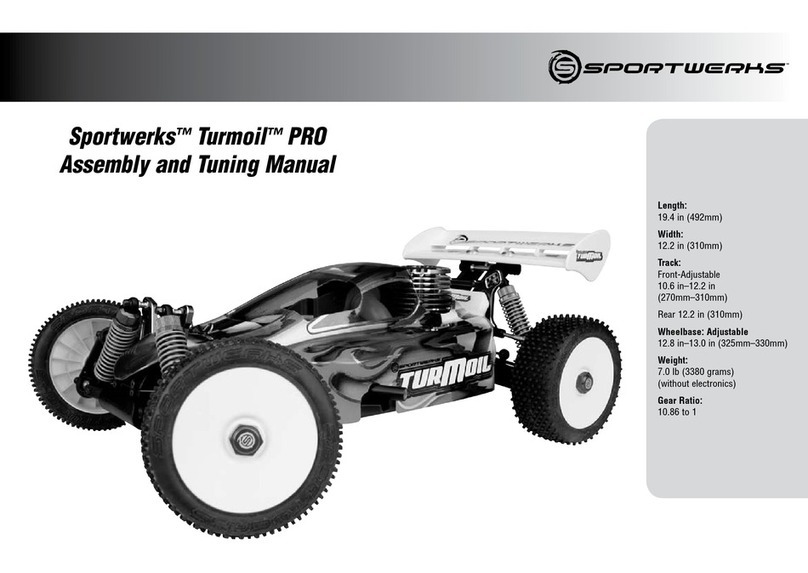
Sportwerks
Sportwerks Turmoil PRO User manual
